Source: Coinbase; Compiled by Wuzhu, Golden Finance
Abstract
We observed the growth of total locked value (TVL) normalized by the appreciation of the native gas token price in L1 and L2 networks.
We separated the impact of CME futures underlying transactions on ETF flows and showed that the growth of non-hedged BTC ETF exposure has slowed significantly since early April.
Foreword
This article reviews the fundamental and technical trends of the crypto market in the first half of 2024 through 10 charts. We studied the growth of total locked value (TVL) normalized by the appreciation of the native gas token price in L1 and L2 networks.
We separated the impact of CME futures underlying transactions on ETF flows and showed that the growth of non-hedged BTC ETF exposure has slowed significantly since early April.
Foreword
This article reviews the fundamental and technical trends of the crypto market in the first half of 2024 through 10 charts ... We also take a relative approach to measure the impulse of on-chain activity in these networks via total transaction fees and active addresses, before specifically analyzing the biggest drivers of transaction fees on Ethereum. We then examine on-chain supply dynamics, correlations, and the current state of liquidity in crypto spot and futures markets.
Separately, one of the more closely tracked metrics in crypto is the inflows and outflows of US spot Bitcoin ETFs, which is often viewed as a proxy for changes in demand for crypto. However, the year-to-date growth in CME Bitcoin futures open interest (OI) suggests that some of the ETF inflows since launch have been driven by underlying trading. We isolate the impact of underlying trading in CME futures, showing that the growth of unhedged BTC ETF exposure has slowed significantly since early April.
Fundamentals
Growth in TVL
We do not compare raw TVL across chains, but instead track TVL growth normalized by the price appreciation of their native gas tokens. Typically, native tokens make up a large portion of TVL in an ecosystem due to collateral or liquidity use. Adjusting TVL growth by price growth helps isolate how much of TVL growth is from net new value creation versus pure price appreciation.
Overall, year-to-date TVL growth has outpaced total cryptocurrency market cap growth by 24%. The fastest growing chains - TON, Aptos, Sui, and Base can all be considered relatively new and benefited from a rapid growth phase.
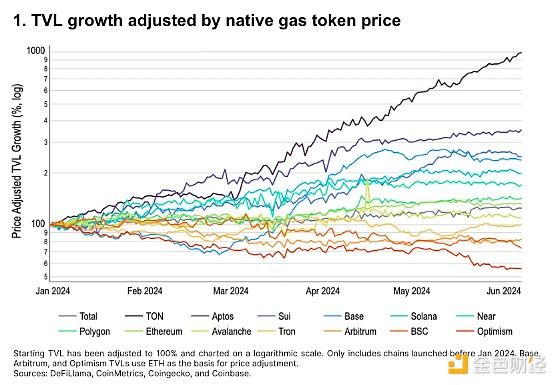
Fees and Users
We compared each network’s (1) average daily active addresses in May with (2) average daily fees or revenue over the same period, both measured as standard deviation compared to the prior four months (January–April). The results show that:
Except for Solana and Tron, on-chain fees generally declined in May;
Active addresses on Ethereum L2 (especially Arbitrum) increased significantly as fees fell after EIP-4844;
Fees on Cardano and Binance Smart Chain were lower than the decline in wallet activity.
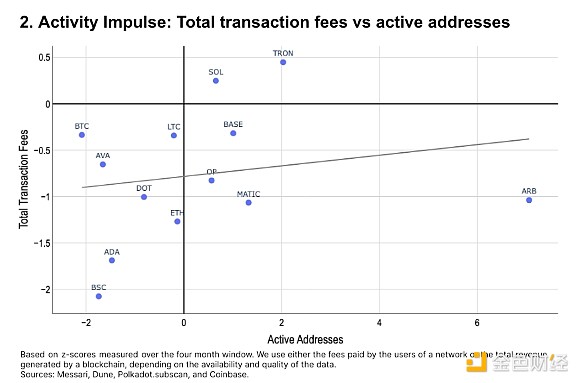
Transaction fee drivers
Categorize the fee details of the top 50 contracts on Ethereum. Together, these contracts account for over 55% of total gas spend YTD.
Following the Dencun upgrade in March, Rollup spend has gradually decreased from 12% of mainnet fees to <1%. MEV (maximum extractable value) driven activity has risen from 8% to 14% of transaction fees, and direct transaction fees have risen from 20% to 36%. While ETH has seen inflation since mid-April, we believe the return of market volatility (and high-value transaction block demand) may offset this trend.
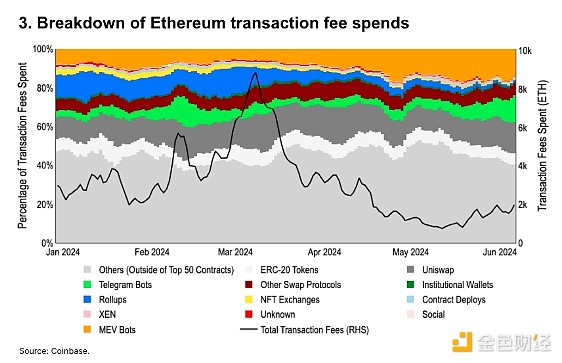
Ethereum L2 Growth
Ethereum L2's TVL has increased 2.4 times year-to-date, with L2's total TVL at $9.4 billion as of the end of May. As of early June, Base currently accounts for approximately 19% of L2's total TVL, second only to Arbitrum (33%) and Blast (24%).
Meanwhile, while TVL (and transaction counts on many chains) are at all-time highs, total transaction fees have fallen significantly since the launch of blob storage in the Dencun upgrade on March 13.
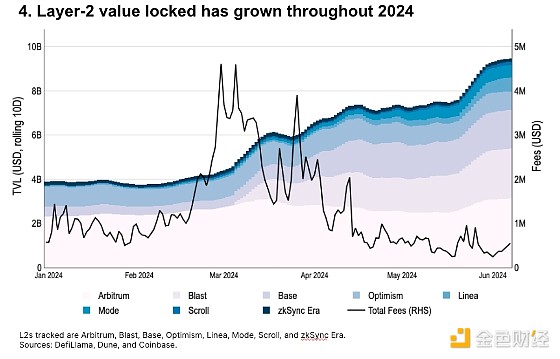
Bitcoin Active Supply Change
Declines in active BTC supply (which we define as BTC that has moved in the past 3 months) have historically lagged local price peaks, indicating a slowdown in market volume. Active BTC supply peaked at a local peak of 4 million BTC in early April — the highest level since the first half of 2021 — before falling to 3.1 million BTC in early June.
But at the same time, BTC’s inactive supply (i.e., BTC that hasn’t moved more in over a year) has remained flat year to date. We believe this indicates that short-term market excitement has faded, even as long-term cyclical investors remain concerned.

Technical
Correlation
Based on a 90-day window, Bitcoin returns appear to be moderately correlated with daily changes in a number of key macroeconomic factors. These include U.S. equities, commodities, and the multilateral dollar index, although the positive correlation with gold remains relatively weak.
Meanwhile, the correlation between Ethereum and S&P 500 returns (0.37) is nearly identical to the correlation between Bitcoin and the S&P 500 (0.36). Trading correlations between cryptocurrency pairs remain high compared to across sectors, though the BTC/ETH correlation has fallen slightly to 0.81 from a peak of 0.85 in March-April.
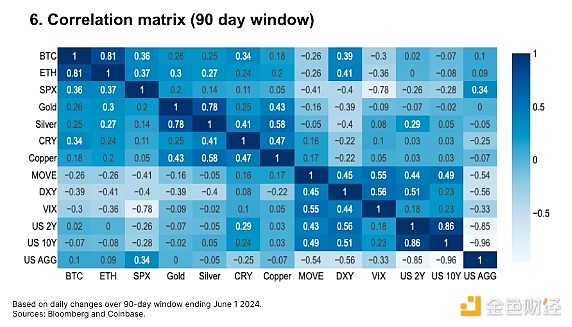
Increasing Market Liquidity
Total daily average trading volume for BTC and ETH, both spot and futures, fell 34% from the peak of $111.5 billion in March 2024. Nevertheless, May's trading volume ($74.6 billion) was higher than every other month since September 2022, with the exception of March 2023.
After the US spot Bitcoin ETF was approved in January, spot Bitcoin trading volume also rebounded significantly. In May, the spot centralized exchange (CEX) Bitcoin trading volume was 50% higher than in December (US$7.6 billion vs. US$5.1 billion). In May, the spot Bitcoin ETF trading volume was US$1.2 billion, accounting for 14% of the global spot trading volume.
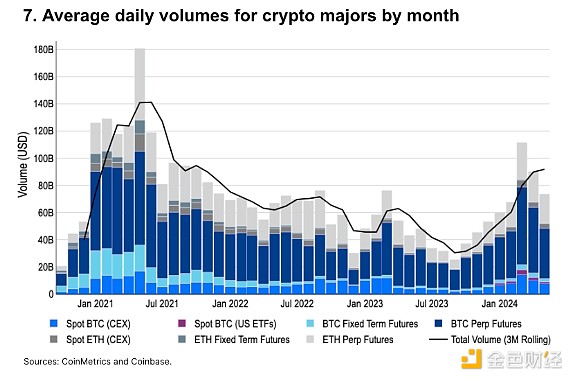
CME Bitcoin Futures
Since the beginning of 2024, CME OI has increased 2.2 times (from $4.5 billion to $9.7 billion), and increased 8.1 times (to $1.2 billion) since the beginning of 2023. We believe that most of the new flows so far this year can be attributed to basis trading after the spot ETF was approved. Following the launch, Bitcoin basis trading can now be done entirely with traditional securities brokers in the US.
Perps OI also increased from $9.8 billion to $16.6 billion year-to-date, keeping CME's share of OI at around 30% (29-32%) for the full year.That being said,CME futures' market share has increased significantly from 16% at the beginning of 2023, indicatingincreased interest from institutions within the US.
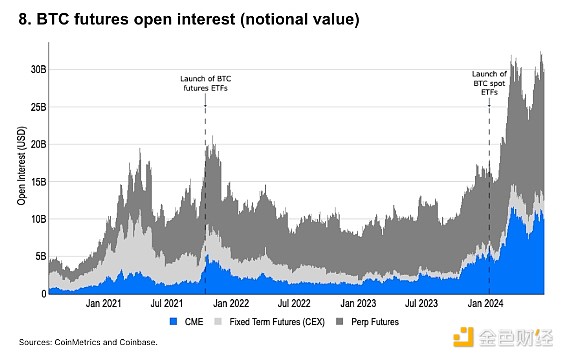
CME Ethereum Futures
CME ETH Futures OI is close to all-time highs. However, ETH OI is still dominated by perpetual futures contracts, which are only available in certain non-US jurisdictions. As of June 1, 85% of total OI ($12.1 billion) came from perpetual contracts, while CME futures accounted for only 8% ($1.1 billion).
The impact of endogenous ETH catalysts on OI is usually obvious, and the last time OI surged was after the US approved the spot ETH ETF (19b-4 filing). Prior to that, OI peaked on March 13 when Dencun was upgraded.
In addition, traditional fixed-term futures on centralized exchanges are still popular, with OI volumes similar to CME futures.
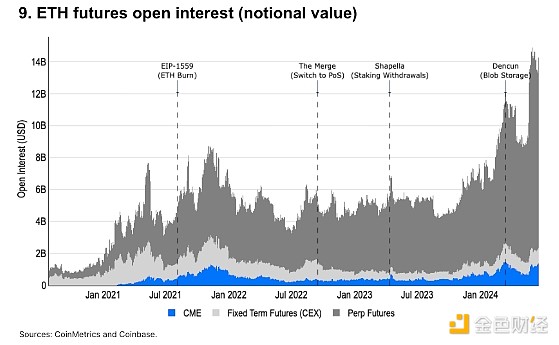
Isolating CME Bitcoin Basis Trades
Normalizing the total spot ETF market capitalization to the CME Bitcoin OI shows that most of the spot ETF flow since early April (day 55) can be attributed to basis trades.
After the spot ETF was approved, the amount of BTC in ETF custody increased by about 200,000 BTC as of March 13 (day 43). This suggests that there was directional buying of BTC during this period, which partly explains the price increase during this period. Since then, the number of BTC managed by the ETF has remained in a range of 825,000-850,000 until the end of May when it broke out of this range strongly.
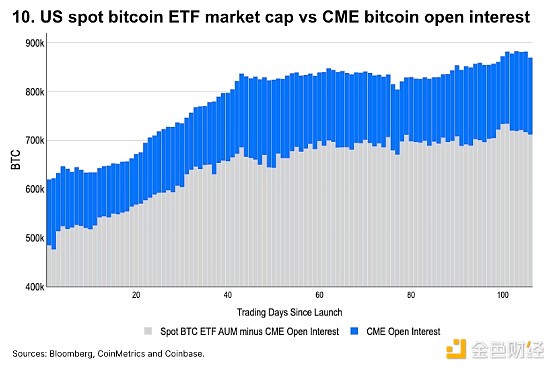
 JinseFinance
JinseFinance













